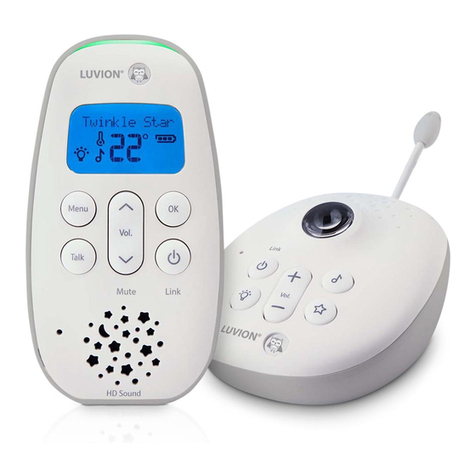Side Controls
7. Sound Alarm Trigger – Adjust the trigger to set the
sound alarm sensitivity. The receiver will beep to alert the
user when the sound is above a preset sound level. Adjust
the side wheel to increase or decrease the level.
8. Camera ON/OFF Switch – Turns the camera ON or OFF.
Camera Installation
Before you install the camera, carefully plan where and how
it will be positioned, and where you will route the cable that
connects the camera to the power adaptor.
Before starting permanent installation, verify its performance by observing the image on the receiver
when camera is positioned in the same location/position where it will be permanently installed and the
receiver is placed in the location where it will be used most of the time.
Installation Warnings
Aim the camera(s) to best optimize the viewing area: Select a location for the camera that provides a
clear view of the area you want to monitor, which is free from dust, and is not in line-of-sight to a strong
light source or direct sunlight.
Avoid installing the cameras where there are thick walls, or obstructions between the Cameras and the
Receiver.
Night Vision
This camera has built-in IR LEDs, which provides the camera with the ability to view images in no/low
light conditions. It is important to use the provided power adaptor (and not the batteries) when using the
camera for prolonged periods in low light conditions, as the built-in IR LEDs will drain the battery more
quickly than regular daytime use.
Installing the Camera
1. Carefully unpack the camera.
5
NOTE: If you are installing cameras that did not come with the
system, please see the pairing camera section of this manual for
details on installation.
2. Mount the camera to the wall.
Mark the position of the screw holes on the wall, and drill holes
and insert 2 screws, then firmly attach the camera to the wall by
placing the stand over the installed screws and pushing the base
downwards.
NOTE: The camera can also be placed on a flat surface, such as a
Table or Shelf, and no mounting hardware is required.
3. Adjust the viewing angle of the camera
NOTE: You can install additional cameras (maximum of 4 cameras). When adding cameras that were
not included in the original box, you will need to pair up the cameras with the receiver. Refer to the
camera pairing section of this manual.




























